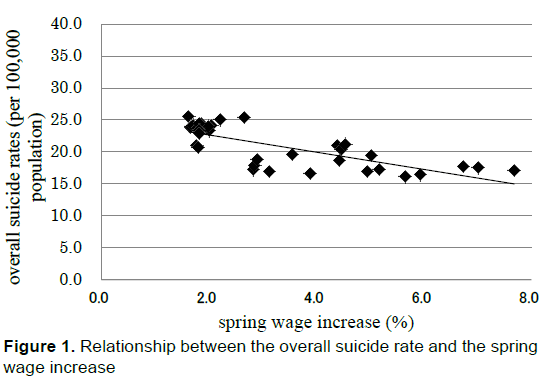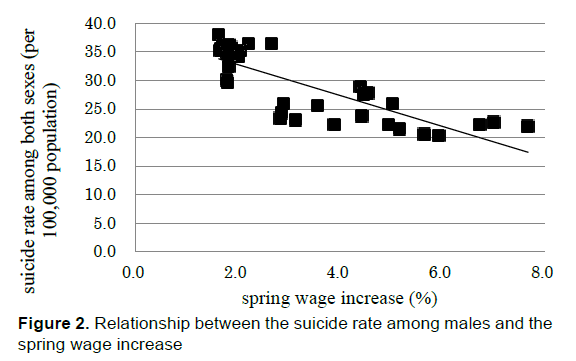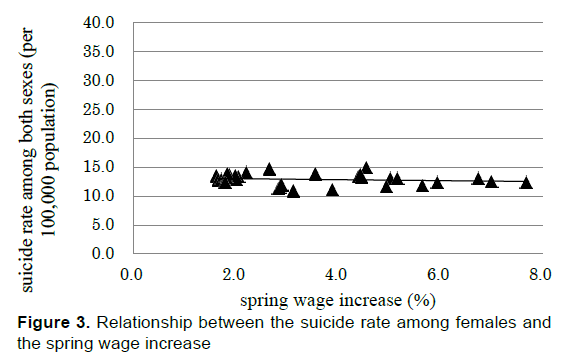Short Article Open Access
A Study of the Relationship between Japans Suicide Rate and the Spring Wage Increase over a Period of 34 Years: Devising Future Suicide Prevention Measures for Various Countries and Examining Numerous Issues Related to Suicide
Ken Inoue1*, Yasuyuki Fujita 2, Yoshihiro Noso3 , Haruo Takeshita4, Nobuo Takeichi2, Masaharu Hoshi5, Tolebay K. Rakhypbekov 2,6, Nailya Chayzhunusova7, Nargul Ospanova 8, Timur Moldagaliev 8, Zhanat Sarsembina 8, Akerke Kalieva9, Ulzhan Jamedinova9, Chegedekova Sholpan9, Sharapiyeva Alua9, Bitebayeva Dina9, Rei Wake10, Tsuyoshi Miyaoka10, Yoshikazu Takinami11,Yuji Okazaki 12, Jun Horiguchi101Department of Public Health, Gunma University Graduate School of Medicine, Gunma, Japan
2Faculty of Medicine, Shimane University, Shimane, Japan
3Department of General Medicine, Faculty of Medicine, Shimane University, Shimane, Japan
4Department of Legal Medicine, Faculty of Medicine, Shimane University, Shimane, Japan
5Research Institute for Radiation Biology and Medicine, Hiroshima University, Japan
6Rector of Semey State Medical University, Semey, Kazakhstan
7Department of Nutrition and Hygienic disciplines, Semey State Medical University, Semey, Kazakhstan
8Department of Neurology, Psychiatry and Infectious diseases, Semey State Medical University, Semey, Kazakhstan
9Department of Public Health, Semey State Medical University, Semey, Kazakhstan
10Department of Psychiatry, Faculty of Medicine, Shimane University, Shimane, Japan
11Department of Emergency and Critical Care Medicine, Faculty of Medicine, Shimane University, Shimane, Japan
12Tokyo Metropolitan Matsuzawa Hospital, Tokyo, Japan
- *Corresponding Author:
- Ken Inoue
Department of Public Health
Gunma University Graduate School of Medicine
Gunma, Japan
E-mail: ke-inoue@med.shimane-u.ac.jp
Visit for more related articles at International Journal of Emergency Mental Health and Human Resilience
Abstract
Japan had around 20,000 suicides in the early 1990s, but the annual number of suicides increased abruptly to over 30,000 in 1998. Devising and implementing suicide prevention measures to reduce the number of suicides has become a societal issue that Japan should promptly address. Over the past few years, suicides in Japan have decreased, but the suicide rate in Japan remains high in comparison to the rest of the world. We believe that clearly identifying factors and issues related to suicide and implementing specific preventive measures to address those factors are crucial to preventing suicide. The current study examines the relationship between suicide and financial issues over a prolonged period. Specifically, it examines the annual suicide rate (per 100,000 populations) during 1980–2013 and the spring wage increase (%) at major companies in Japan during the same period. This study examines suicide rate and spring wage increase statistics in detail.
We found the spring wage increase may be related to the overall (both-gender) suicide rate. Closer examination suggested that the spring wage increase is related to the suicide rate among males but not among females.
Financial hardships and financial difficulties can lead to mental exhaustion and stress. A key measure to preventing suicide due to financial reasons is providing mental health support to individuals facing financial problems. Suicide prevention measures should be coordinated by relevant bodies and the community. Such efforts in Japan and elsewhere around the world should be based on statistical analysis of the factors involved in suicide.
Keywords
Suicide, Spring Wage Increase, Relationship
Introduction
A recent report by the National Police Agency (Cabinet Office, 2015) indicated that Japan had around 21,000 to 24,000 annual suicides in the years 1990�¢â�¬â��1997, but that this figure abruptly increased to 32,863 in 1998. From 1998 to 2011, Japan continued to have 30,000 or more annual suicides, though this figure dropped to below 30,000 from 2012 onward. Over the past few years, the suicide rate in Japan has decreased, but Japan still has one of the world�¢â�¬â�¢s highest overall suicide rates and high suicide rates among both men and women (Cabinet Office, 2015). The context for the abrupt increase in suicides in Japan in 1998 was an increase in suicides among middle-aged males due to economic and life problems (Inoue et al., 2011; Ono, 2006). We previously reported that unemployment (Inoue et al., 2006), stock prices (Inoue, Fukunaga & Okazaki, 2012b), poverty rates (Inoue et al., in press), the average disposable income per household (Inoue et al., 2014), and the number of new housing starts (Inoue, Fukunaga,, Fujita & Okazaki, 2012a) are financial and lifestyle factors related or correlated to suicide in Japan. One study (Motohashi, Jung-Choi, Jun & Kawachi, 1991) described a period when the overall suicide rate in Japan was closely related to the unemployment rate and the labor force and a period when the divorce rate and tertiary industry had a major impact on the suicide rate. In another study, suicide mortality among males showed a positive association with working away from home (Otsu, Araki, Sakai, Yokoyama & Voorhees, 2004).
Foreign studies have described financial and lifestyle factors related to suicide trends (Kim, Jung-Choi, Jun & Kawachi, 2010; Inoue et al., 2010; Masedo-Gutierrez & Moreno-Kustner, 2015; Fountoulakis et al., 2015; Saurina Marzo & Saez, 2015; Stuckler et al., 2009). In South Korea, significantly higher suicide rate were related to a lower level of education and residence in rural and economically depressed areas (Kim et al., 2010). One study from South Korea found that the suicide rate there was related to the unemployment rate, but that increased rates of mining and industrial production and increased rates of money supply were not related to the suicide rate (Inoue et al., 2010). In a recent study, Masedo-Gutierrez and Moreno-Kustner (Masedo-Gutierrez & Moreno-Kustner, 2015) suggested that unemployment rates and suicide rates are too general as parameters. Another recent study (Fountoulakis et al., 2015) in Thessaloniki of Greece reported that suicide attempts were inversely correlated with unemployment and that completed suicides were correlated with unemployment. However, in a study of Catalonia of Spain, Saurina et al (Saurina, Marzo & Saez, 2015) found no clear relationship between higher suicide rates and an increase in unemployment. Stuckler et al. (Stuckler et al., 2009) reported that every US$10 per person increased investment in active labor market programs decreased the effect of unemployment on suicides by 0.038%.
Studies in Japan and overseas have not yielded consistent results, particularly with regard to financial factors related to suicide and financial measures that could serve as predictors of suicide trends. We agreed with a recent study arguing that it was important to study such relationships over several different periods (Fu et al., 2013). In other words, trends in suicide in relation to financial factors and financial measures need to be studied over longer periods of time for meaningful relationships to emerge. The spring wage increase is the average wage increase in Japan; the current study specifically examined the statistical relationship between suicide and the spring wage increase as a key financial factor over a period of 34 years.
Methods
This study examined Japan’s annual suicide number (people) and annual suicide rate (per 100,000 population) from 1980–2013, overall and by sex, based on Vital Statistics of the Ministry of Health, Labour and Welfare published by the Cabinet Office (Cabinet Office, 2015).
The current study also examined the spring wage increase (%) at major companies during the same period. Wage increases at major companies were compiled by the Ministry of Health, Labour and Welfare (Ministry of Health, Labour and Welfare, 2015).
The coefficients of correlation between the suicide rate and the spring wage increase during the period studied were determined using an Excel spreadsheet. Single regression analysis of the relationship between the suicide rate and the spring wage increase was performed using an Excel spreadsheet. This study used only numerical data without information pertaining to the individuals themselves.
Results
During the period studied, the annual number of suicides ranged from 19,875 to 32,109. The number among males was 12,316‒23,396 and that among females was 6,865‒9,406.
During the period studied, the overall suicide rate each year ranged from 16.1 to 25.5 (per 100,000 population). The suicide rate among males was 20.4‒38.0 and that among females was from 10.9‒14.9.
The wage increases from 1980–2003 were determined for companies listed in the First Section of the Tokyo Stock Exchange or the Osaka Securities Exchange that had capital of 2 billion yen or more and a labor union consisting of 1,000 or more employees (Ministry of Health, Labour and Welfare, 2015). The wage increases from 2004 to 2013 were determined for companies that had capital of 1 billion yen or more and a labor union consisting of 1,000 or more employees (Ministry of Health, Labour and Welfare, 2015).
During the period studied, the spring wage increase was from 1.63 to 7.68 (%).
During the period studied, the coefficient of correlation between the suicide rate and the spring wage increase was r = −0.756 overall. The coefficient of correlation between the suicide rate and the spring wage increase was r = −0.808 among males and r = −0.161 among females.
The relationship between the overall suicide rate and the spring wage increase was found to be R2 = 0.5718, p < 0.001 and y = −1.3490x+ 25.359 (Figure 1). The relationship between the suicide rate among males and the spring wage increase was found to be R2 = 0.6536, p < 0.001 and y = −2.7002x + 38.179 (Figure 2). The relationship between the suicide rate among females and the spring wage increase was found to be R2 = 0.0260, p = 0.362 and y = −0.0866x + 13.185 (Figure 3).
Discussion and Conclusions
The current results suggested that the spring wage increase is probably related to the overall suicide rate. The spring wage increase is related to the suicide rate among males but not to the suicide rate among females.
Several studies (Liu et al., 2013; Inoue et al., 2009; Yamasaki Sakai, & Shirakawa, 2005) in Japan have reported that suicide is more closely related to the effects of financial issues among males than among females. In my previous study (Inoue et al., 2012c), issues related to suicide among females and likely the underlying trends have a strong biological component. By contrast, issues related to suicide among males and likely underlying trends often involve financial factors as the underlying issue.
The current results have suggested a potential relationship between suicide and the spring wage increase. This relationship was shown to be particularly strong in males, and this tendency was similar to the trend in financial problems as the reason for the rapid increase in suicides in 1998 in Japan. Financial hardships and financial difficulties can lead to mental exhaustion and stress, and people who face financial problems need to receive mental health support to prevent suicide due to financial reasons (Glonti et al., 2015; Simou & Koutsogeorgou, 2014; Inoue & Tanii, 2008). In specific terms, coordinated responses by the medical establishment (clinical and social medicine), economics experts, administrative bodies, the legal system, colleagues in the same occupation, and the community must be made when necessary, and suicide prevention measures must be devised. In the future, we hope to continue to study suicide from various perspectives in order to provide data for the development of further effective suicide prevention measures.
References
- Cabinet Office (2015). Heisei27nenbanjisatsutaisakuhakusho. Shobi Printing Company Ltd, 36 and 219 .
- Fountoulakis, K.N., Savopoulos, C., Apostolopoulou, M., Dampali, R., Zaggelidou, E., Karlafti, E., et al. (2015). Rate of suicide and suicide attempts and their relationship to unemployment in Thessaloniki Greece (2000-2012). Journal of Affective Disorders, 174, 131-136.
- Fu, T.S., Lee, C.S., Gunnell, D., Lee, W.C.&Cheng, A.T (2013). Changing trends in the prevalence of common mental disorders in Taiwan: a 20-yearrepeatedcross-sectional survey. Lancet, 381, 235-241.
- Glonti, K., Gordeev, V.S., Goryakin, Y., Reeves, A., Stuckler, D., McKee, M., et al. (2015). A systematic review on health resilience to economic crises.PLoS One, 10, e0123117.
- Inoue, K., Fujita, Y., Okazaki, Y., Masaki, M., Ono, Y.& Fukunaga, T. (2009). A report of recent suicides in Japan.West Indian Medical Journal, 58, 494.
- Inoue, K., Fujita, Y., Takeshita, H., Abe, S., Fujihara, J., Ezoe, S., et al. (2016). A long-term study of the association between the relative poverty rate and suicide rate in Japan.Journal of Forensic Sciences, 61, S140-143.
- Inoue, K., Fukunaga, T., Fujita, Y., Iida, T., Abe, S.& Ono, Y. (2011). Reasons for the Increase in Suicides in Japan. International Medical Journal, 18, 176-178.
- Inoue, K., Fukunaga, T., Fujita, Y.&Okazaki, Y. (2012a). Can the Number of New Housing Starts Serve as an Indicator of Suicide Trends in Japan?� Exploring Potential Indicators to Prevent Suicides. International Medical Journal, 19, 297-298.
- Inoue, K., Fukunaga, T.&Okazaki, Y. (2012b). Study of an economic issue as a possible indicator of suicide risk: a discussion of stock prices and suicide.Journal of Forensic Sciences, 57, 783-785.
- Inoue, K., Nishimura, Y., Fujita, Y., Ono, Y.& Fukunaga T. (2012c). The relationship between suicide and five climate issues in a large-scale and long-term study in Japan. West Indian Medical Journal, 61, 532-537.
- Inoue, K., Nishimura, Y., Nishida, A., Fukunaga, T., Masaki, M., Fujita, Y., et al. (2010). Relationships between suicide and three economic factors in South Korea. Legal Medicine, 12, 100-101.
- Inoue, K., Nishimura, Y., Okazazi, Y.&Fukunaga, T. (2014). Discussion based on analysis of the suicide rate and the average disposable income per household in Japan.West Indian Medical Journal, 63, 340-343.
- Inoue, K.&Tanii, H. (2008). The measures of suicidal prevention in Mie Prefecture, Japan.Journal of Forensic and Legal Medicine, 15, 411-412.
- Inoue, K., Tanii, H., Abe, S., Kaiya, H., Nata, M.&Fukunaga, T. (2006). The Correlation between Rates of Unemployment and Suicide Rates in Japan between 1985 and 2002. International Medical Journal, 13, 261-263.
- Kim, M.H., Jung-Choi, K., Jun, H.J.&Kawachi, I. (2010). Socioeconomic inequalities in suicidal ideation, parasuicides, and completed suicides in South Korea. Social Science & Medicine, 70, 1254-1261.
- Liu, Y., Zhang, Y., Cho, Y.T.,Obayashi, Y., Arai, A.&Tamashiro, H. (2013). Gender differences of suicide in Japan, 1947-2010. Journal of Affective Disorders, 151, 325-330.
- Masedo-Gutierrez, AI.&Moreno-Kustner, B. (2015). Economic crisis and mortality by suicide: two concepts hard to link. European Journal of Public Health, 25, 900.
- Ministry of Health Labour and Welfare. http://www.mhlw.go.jp/file/04-Houdouhappyou-12604000-Seisakutoukatsukan-Sanjikanshitsu_Roushikankeitantou/0000052265.pdf. Last accessed 17 January 2015.
- Motohashi, Y. (1991). Effects of socioeconomic factors on secular trends in suicide in Japan, 1953-86.Journal of Biosocial Science, 23, 221-227.
- Ono, Y. (2006).Suicide prevention program in Japan. Psychiatry, 8, 365-368.
- Otsu, A., Araki, S., Sakai, R., Yokoyama, K.&Voorhees, A.S. (2004). Effects of urbanization, economic development, and migration of workers on suicide mortality in Japan.Social Science & Medicine, 58, 1137-1146.
- Saurina, C., Marzo, M.&Saez, M. (2015). Inequalities in suicide mortality rates and the economic recession in the municipalities of Catalonia, Spain. International Journal for Equity in Health, 14, 75.
- Simou, E.&Koutsogeorgou, E. (2014). Effects of the economic crisis on health and healthcare in Greece in the literature from 2009 to 2013: a systematic review.Health Policy, 115, 111-119.
- Stuckler, D., Basu, S., Suhrcke, M., Coutts, A.& McKee, M. (2009). The public health effect of economic crises and alternative policy responses in Europe: an empirical analysis.Lancet, 374, 315-323.
- Yamasaki, A., Sakai, R.&Shirakawa, T. (2005). Low income, unemployment, and suicide mortality rates for middle-age persons in Japan.Psychological Reports, 96, 337-348.
Relevant Topics
Recommended Journals
Article Tools
Article Usage
- Total views: 12749
- [From(publication date):
June-2016 - Mar 31, 2025] - Breakdown by view type
- HTML page views : 11750
- PDF downloads : 999



